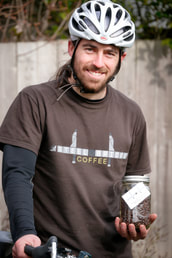|
_ Steel Bridge Coffee offers three basic roast levels: light, medium, and dark. [PLEASE NOTE, WE NO LONGER OFFER "LIGHT ROAST"] But what do those words actually mean? Since there are no universally accepted standards for the meaning of roasting terms, this article is intended to help you understand what they mean here.
First, a bit about roasting. Roasting is the process of bringing green, dry coffee beans (in actuality the “seed” of the coffee plant) to a temperature at which its chemical compounds literally change, converting it from an unpalatable substance into what we all know as the basis for a rich and aromatic steeped beverage. As the roasting progresses the beans simultaneously grow in size and lose mass (mostly through water loss), which is why you may notice that 10 ounces of dark roast fills up more of a glass jar than 10 ounces of light or medium roast. When roasted coffee beans reach about 420°F they enter the palatable drinking stage. If the roast hits 485°F then you're probably dealing with a charred, ruined product. Steel Bridge Coffee roasts correspond approximately to the following temperatures: 434°F (light), 448°F (medium), 462°F (dark). The character of roasted coffee relates to processes that occur during the heating of the beans and at what stage the heating is cut off. Roasters pay attention primarily to two stages known as “first crack” and “second crack” (both indicators of pyrolitic reactions in the beans). At around 400°F the beans begin making a cracking sound much like that of popping popcorn. During this cracking period sugars are caramelizing and flavor oils are being released. By 425°F, first crack finishes and the beans are quiet again. Caramelization continues to occur as the beans approach second crack. Second crack begins at around 450°F. This time the beans make a softer but more rapid crackling noise; flavor oils move to the surface of the bean and increasing amounts of smoke are emitted. For Steel Bridge Coffee, our light roast is roasted just a little bit beyond the conclusion of first crack, but well before second crack. This is what might be called a “City Roast” or a “City+ Roast.” Our medium roast is cut off right on the verge of second crack and is what might be called a “Full City Roast.” The dark roast is cut off before the conclusion of second crack and could be called a “Vienna Roast” or a “Light French Roast.” It is possible to roast lighter and darker than the limits of our basic “light” and “dark” roasts, however we try to concentrate on what we believe to be an optimal range. There are a few generalizations that can be made about the flavor characteristics of different roasts. For starters, the darker coffee is roasted the more it loses the distinct characteristics of its region of origin. To put it another way, if you drink light roasted coffee you will likely notice more diversity in your coffee flavor (as you sample coffee from different regions) than if you drink dark roasted coffee. Furthermore, lighter roasts are said to be higher in “acidity,” which in coffee terminology refers to a lively, palate-cleansing flavor (for some people this might be experienced as a positive characteristic, for others negative). Darker roasts are said to be less acidic and fuller in “body,” which refers to the tactile feel of coffee in one's mouth. Many people seem to have the misconception that darker roasts are for more experienced coffee drinkers. The word “light” seems to incorrectly imply “weakness” to many people. Realistically, the “strength” of a coffee beverage is related only to the ratio of grounds to water during brewing. It is true that “light” is the roast of choice for the inferior coffee that is mass produced by the country's major coffee players (e.g. Folgers). This is likely because lighter roasts (more than darker roasts) satisfy that great industrial value of efficiency: they take less time and energy to roast and they can be packaged in a smaller space than a dark roast of equivalent weight. The efficiency of light roasts ought not be disdained by the coffee aficionado. Folgers coffee is poor because of the strain of coffee they use (Robusta) and because it is stale by the time it reaches your cup, not because it is a light roast. As a roaster myself, I quickly came to appreciate roasting efficiency and have become a lover of light-roasted coffee. But darker roasts are not to be ignored, especially for those who are looking to the micro-roasting industry for an alternative to the standard American industrial roast. Dark roasts can offer a richer, smokier, full-bodied cup of coffee that many aficionados crave. A dark roast is also typically recommended for espresso, although there's no reason why you can't run light or medium roasted coffee through your espresso machine. In any case, I hope that you are able to find the roast that suits your tastes or (if you're like me) that you will enjoy sampling a variety of roast profiles. If you are interested in trying something lighter, darker, or in between what Steel Bridge Coffee normally offers, I invite you to order a pound and make a note to me with your roasting request.* Also, stay tuned for information on a Steel Bridge Coffee roast sampling event coming soon. *Since I roast one pound at a time, I will only accommodate special roasting requests on full pound orders.
5 Comments
|
|


